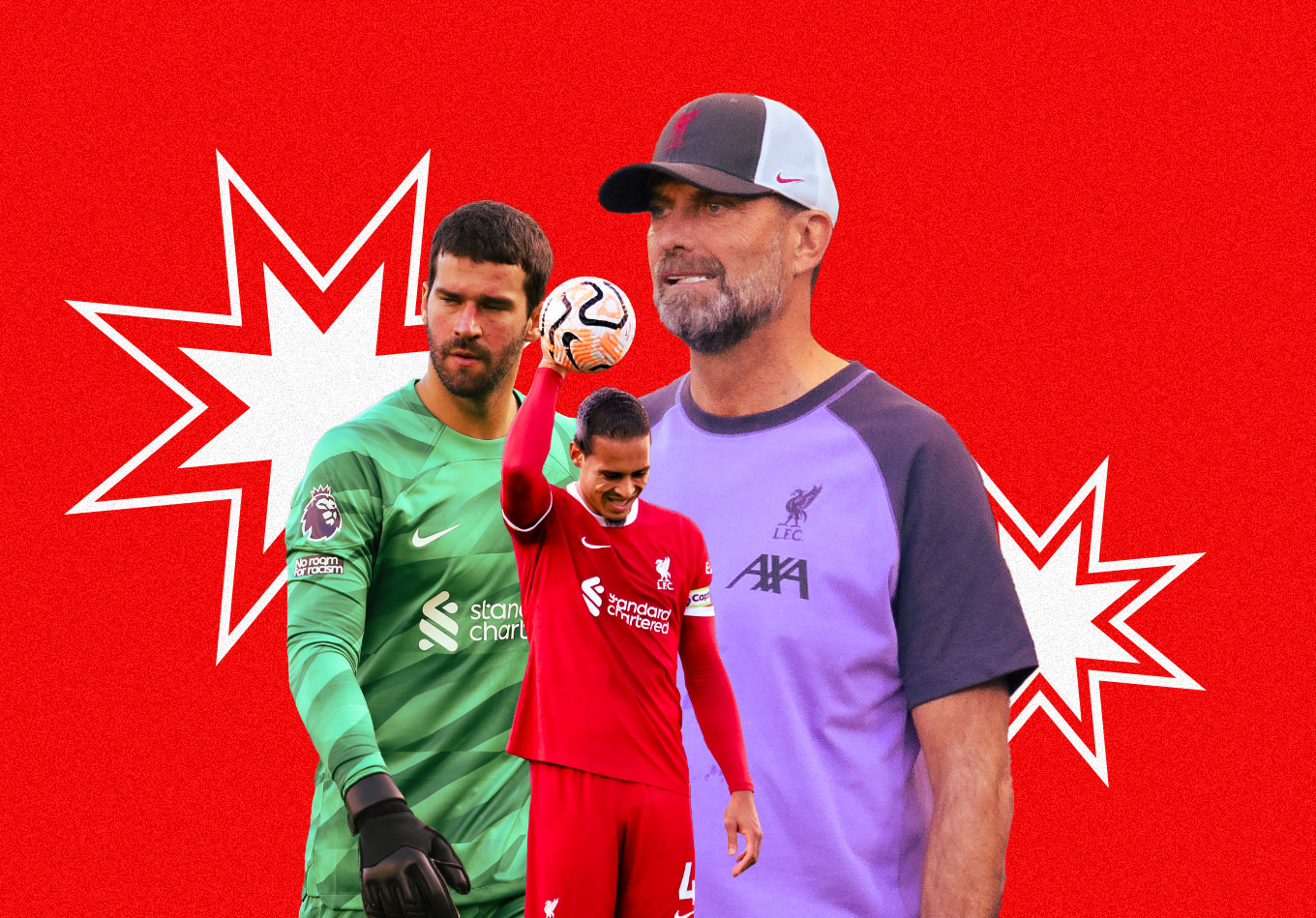Only Sheffield United and Luton Town have conceded the first goal in a Premier League game more often than Liverpool this season, and it’s not a new phenomenon for Jürgen Klopp’s side either.
Doctor Hibbert: “You have an absolutely unique genetic condition known as ‘Homer Simpson syndrome’.”
Homer Simpson: “Oh, why me?!”
Fear not, Homer. It might not just be you.
The condition that enabled the bumbling character from The Simpsons to win boxing matches by allowing his opponent to hit him over and over until he tired them out enough to just nudge them down could also be the inspiration for the tactics of a Premier League giant, though they often struggle to avoid taking damage in the process.
Liverpool keep falling 1-0 behind in games. Simon Adingra’s audacious goal for Brighton on Sunday was yet another that put Jürgen Klopp’s side one down, and it has been a common occurrence in recent times.
Although they had to settle for a point on the south coast, Liverpool had gone from 1-0 down to 2-1 up and do often recover to win in such circumstances, so could it be that they are simply encouraging their opponents to start fast so they tire themselves out and can just be nudged over late in games?
Or are the real reasons less cartoon-based and more football-based?
Slow Starters
Now that our tongue has been removed from our cheek, let us begin. Since the start of last season, Liverpool have conceded first in 21 of their 46 Premier League games, and in 28 of their 63 games in all competitions.
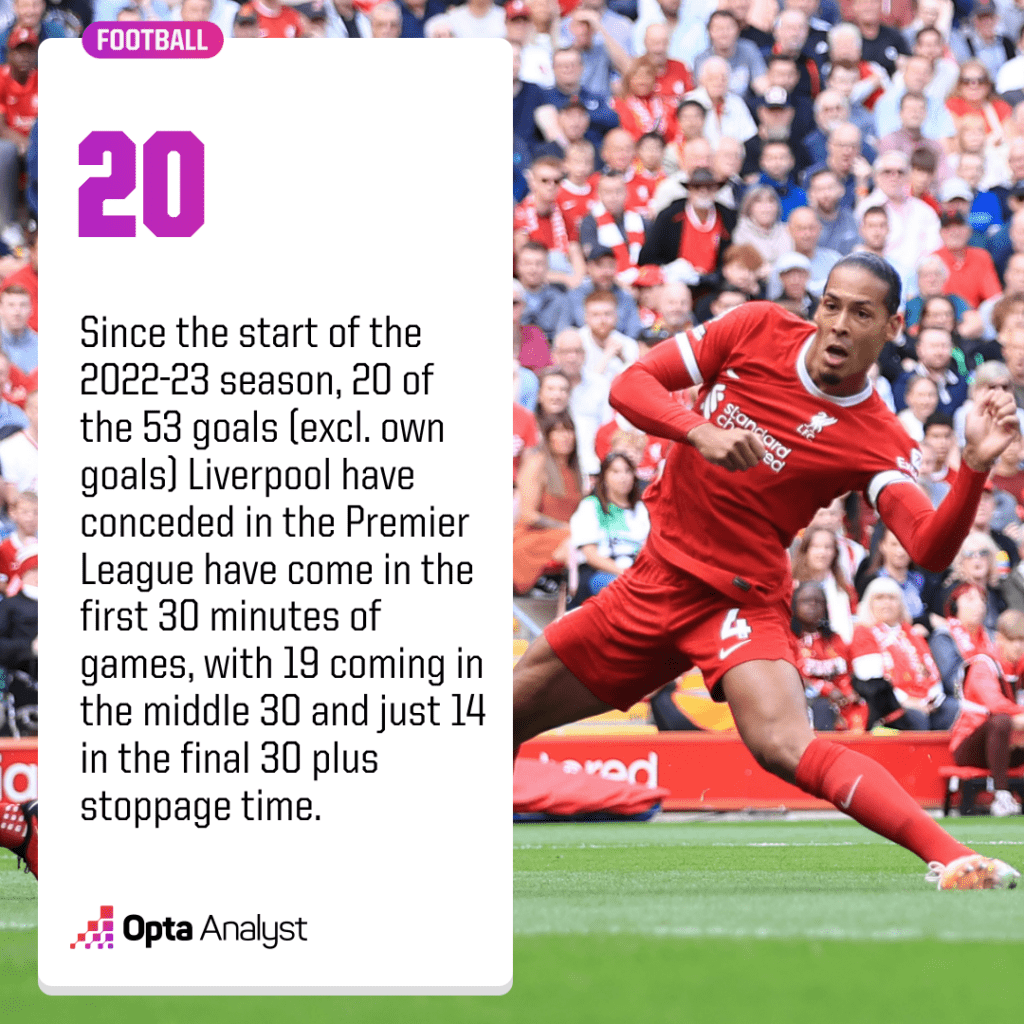
It’s not the worst record in the Premier League in that time. Nine other teams have conceded first more often, with Bournemouth and relegated Southampton leading the way on 28 each.
However, it is still concerning for a team of Liverpool’s stature. They have gone 1-0 down more often than Fulham (20) in the Premier League since the start of last season, for example.
In those 28 games in all competitions in which they have conceded the first goal, Liverpool have gone on to win nine times, draw seven and lose 12. A lot of those defeats and draws last season ended up costing them as they missed out on the top four, while also failing to pick up a trophy having won two and almost securing four the previous campaign.
Their tendency to concede first has carried on into this season, going behind five times in their eight league games – with only Sheffield United and Luton Town (both seven) doing so more often – while also going a goal down at LASK in the UEFA Europa League group stage and against Leicester City in the EFL Cup third round, coming back to win both of those games 3-1.
In the Premier League, Liverpool conceded first against Bournemouth, Newcastle United and Wolverhampton Wanderers, and also managed to win all three games. The ‘mentality monsters’ tag seemed to be back.
Since the start of the 2022-23 season, only Crystal Palace (25) have won more Premier League points after going 1-0 down than Liverpool (24), and Palace have conceded first in four more games (25).
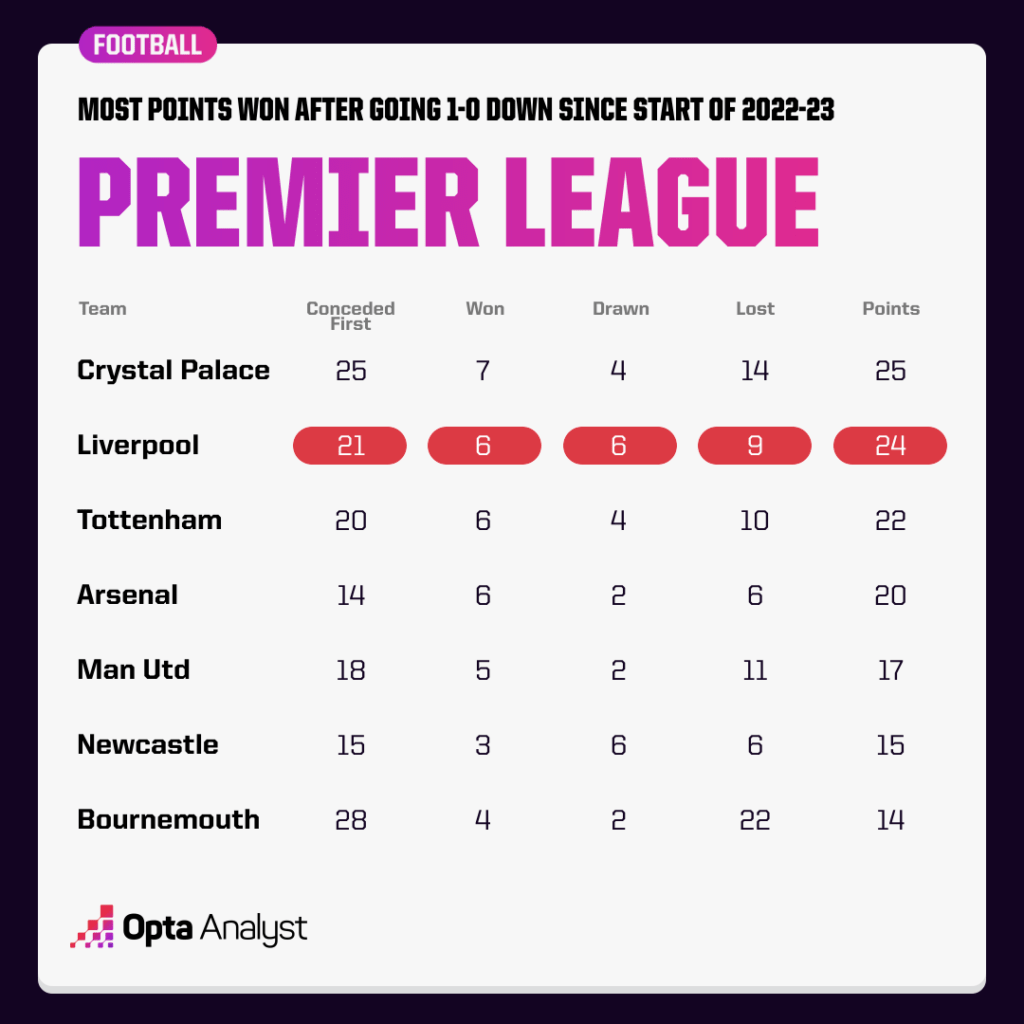
However, Liverpool’s last two outings have also seen them go 1-0 down and ultimately drop five points, losing 2-1 at Tottenham and drawing 2-2 at Brighton. Granted, it’s very harsh to judge them on the Spurs game given Luis Díaz would have put them 1-0 up had the VAR process been half as good as referee Simon Hooper prematurely declared it to be at the time. Still, we all got a good meme out of it.
It’s not a new problem. Back in October 2022, following a 2-1 defeat to Leeds United when Rodrigo Moreno had opened the scoring at Anfield inside four minutes, Klopp said: “Yes, of course it’s concerning [conceding first so often]. But it’s not that we go into each game saying: ‘Make sure we don’t concede the first goal’. That’s clear anyway. It’s clear in football… It’s not [a] self-fulfilling prophecy or whatever that you talk about it and it happens, or you don’t talk about it and it happens.”
The draw at Brighton on Sunday thanks to Mohamed Salah’s brace might end up being seen as a point gained given the Amex Stadium is a notoriously difficult place to visit these days. It was a slow start from Liverpool though, and while Adingra’s cheeky opener in the 20th minute came from nowhere, Brighton’s lead was not that surprising.
So, are Liverpool generally starting games slowly, or have they just been unlucky?
Fifteen-Minute Splits
Separating games into 15-minute chunks, we can look at the breakdown of goals and chances Liverpool have conceded in different stages.
Since the start of last season in the Premier League, 10 of their 53 goals conceded (excluding own goals) have come in the first 15 minutes of matches. Liverpool haven’t conceded more goals in any other 15-minute period of games in that time, with their expected goals (xG) against per game in the first 15 minutes at 0.23. That’s more than in the 16-30th minutes (0.21) even though they have conceded fewer shots and shots on target overall in the first 15 minutes, so they are conceding higher quality chances in the opening quarter of an hour.
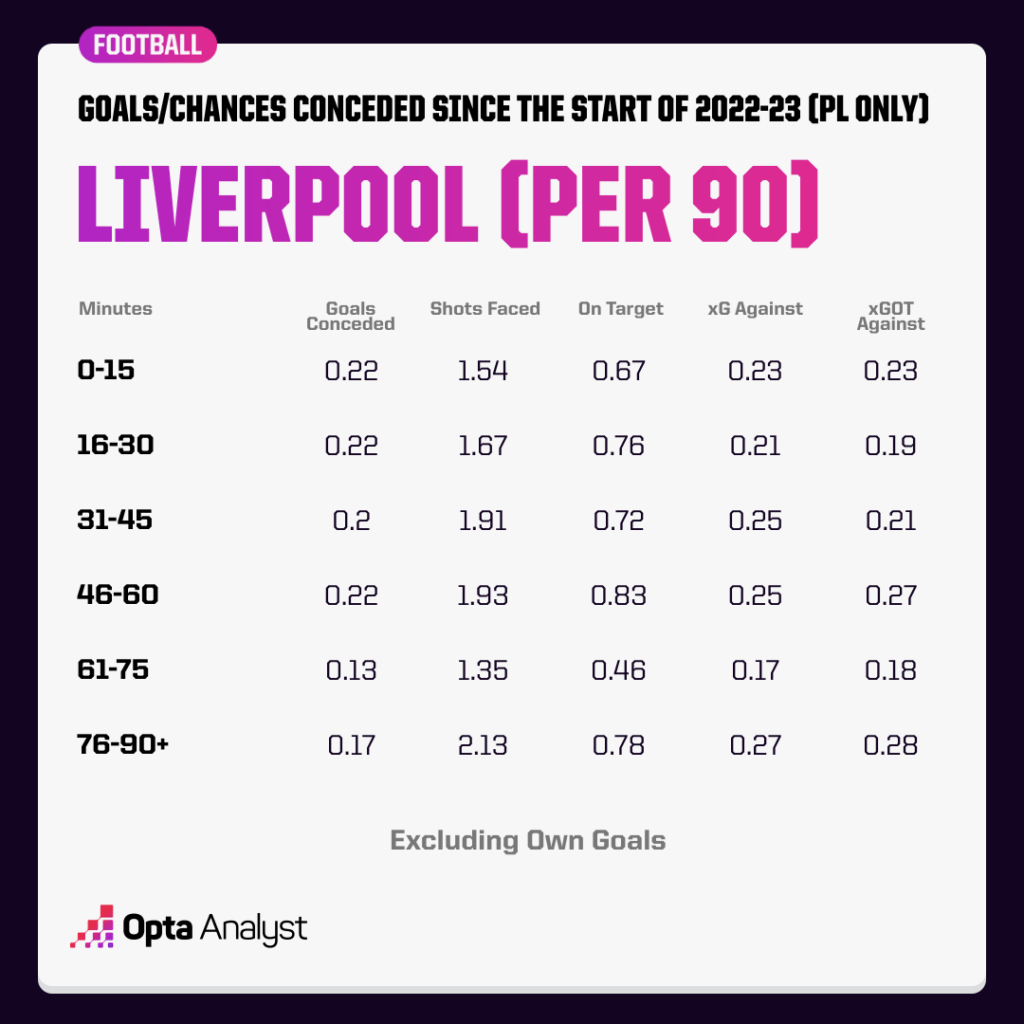
For comparison, all of Manchester City (2), Arsenal (6), Manchester United (8), Newcastle United (8) and even Chelsea (8) have conceded fewer than 10 in the opening 15 minutes of games in that time, though Tottenham have let in a whopping 14. Just one of those has come this season, however, as Ange Postecoglou continues to correct that ship.
Compare Liverpool’s xG against in the first halves of Premier League games since the start of last season to those who finished in the top four and Chelsea (whose numbers don’t become noticeably bad until the second half), and it’s clear to see why they’re often having to rely on a world-class goalkeeper in Alisson and a fierce attack to win games. Their first-half xG against per game in that time is 0.69, higher than City (0.37), Arsenal (0.48), United (0.59), Newcastle (0.57) and Chelsea (0.56).
Liverpool have faced 5.1 first-half shots on average across those 46 league outings, with only Man Utd of those teams seeing more attempts aimed at their goal (5.4). Liverpool’s 2.2 shots on target faced per game, though, is a lot more than anyone who finished in last season’s top four has faced in that time (Newcastle’s is next highest at 1.6), suggesting they’re either giving up higher quality chances, or opposition players are just shooting particularly accurately against them.
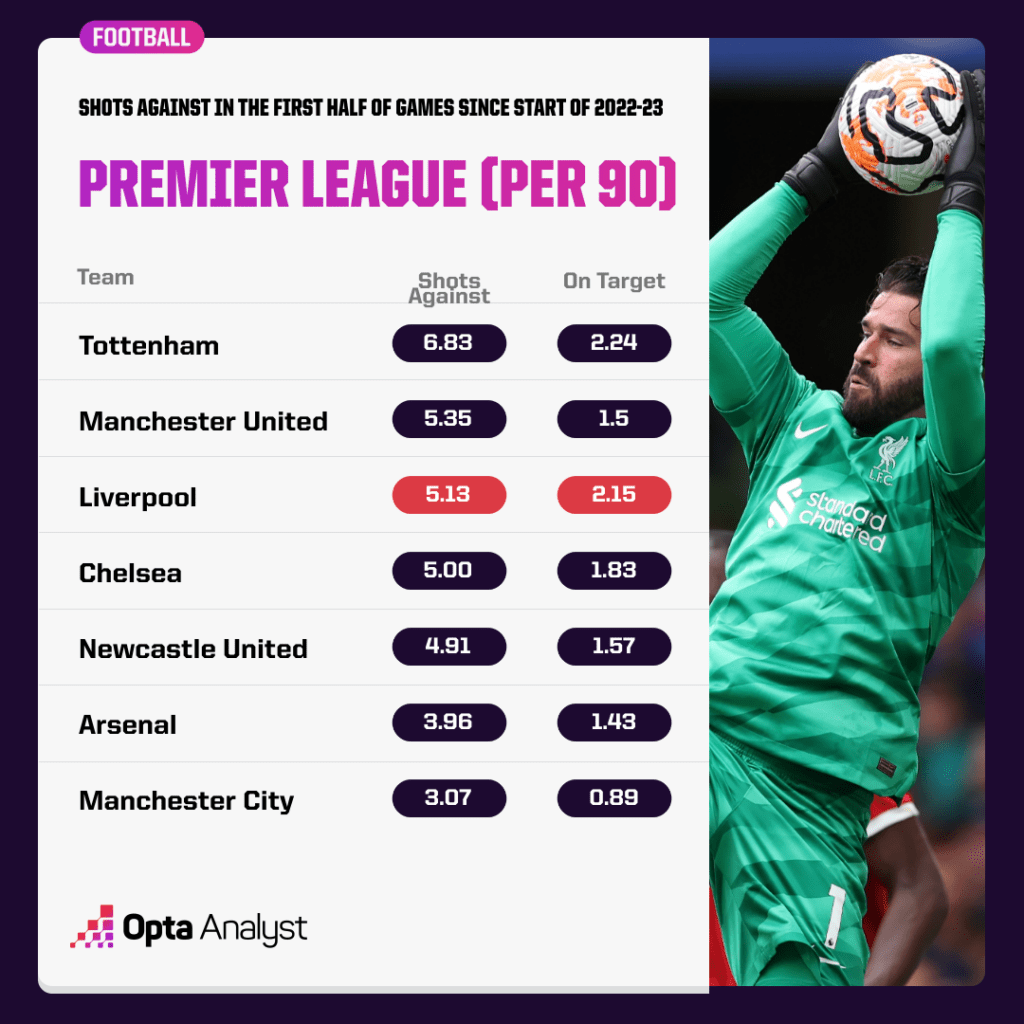
Interestingly, their second-half xG against also averages at 0.69, but that is noteworthy itself given that all other teams apart from Newcastle (0.48) have seen theirs go up after the break (Man City – 0.48, Arsenal – 0.59, Man Utd – 0.8 and Chelsea 0.8).
Having conceded the third fewest shots in the league last season, only six teams have faced more than Liverpool’s 115 shots against this season, which includes the bottom four in the table (along with Wolves – 139, and West Ham – 149). That must be caveated with the fact they’ve played almost 200 of their 720 minutes with fewer men, though, after their four red cards this season.
Despite that, Liverpool have conceded 19 big chances – a chance from which the attacker would be expected to score more often than not – in their eight games (2.38 per game), which is more than nine other Premier League sides but an improvement on last season when they faced on average 2.71 big chances per game, the third-most.
As mentioned, in all competitions since the start of last season, Liverpool have conceded first in 28 of 63 games. Of those 28, only three came in the second half, and Klopp’s men lost on each occasion (Brighton, Nottingham Forest and Real Madrid, all away). That means 25 were conceded in the first half, and of those, Liverpool won as many as they lost (W9, D7, L9). Of those 25, 11 were conceded in the first 10 minutes. This had the silver lining of giving them plenty of time to recover, but also put them on the back foot and derailed their initial plan before they had a chance to settle into games.
On average across those 28 games, Liverpool conceded the opener in the 21st minute, almost exactly when Adingra netted at the Amex last time out. Perhaps Liverpool need to play more conservatively in the first quarter of games, or simply figure out how to get into their rhythm quicker.
Klopp talks about the “rhythm” of his team a lot, and you can see why. In those 15-minute breakdowns, Liverpool have conceded their fewest xG against in the 61st-75th minute period, while their second-best is the 16-30th minute slot, the two middle sections of each half. They also average a fairly high 0.25 xG against per game in the first 15 minutes of the second half, suggesting they generally need at least 15 minutes to get control of things in each period. They have conceded 20 goals in the first 15 minutes of each half combined (10 each), which is 15 more than Man City, who have conceded only two in the first 15 of the first half, and three in the first 15 of the second.
Liverpool really seem to calm things down in that 61-75 minute period, though, showing that they are capable of controlling games. Perhaps it can be explained by that being a time when the opposition are protecting a lead or a draw, but they have almost conceded half as many goals in that time as they have in the opening 15 minutes of games.
Can It Be Fixed?
This will all have occurred to Klopp and his coaches, of course, and as he said last October, it’s not as if they’re doing it on purpose (there goes our Simpsons-based theory). It is perhaps just a side effect of what is a pretty high-risk, high-reward approach for a team that plays with a high line and an aggressive press, sometimes leaving themselves vulnerable to wide open spaces if teams can beat that press.
It’s also not to say that Liverpool’s defence isn’t good enough. Klopp often stresses that his team defends from the front, while questions have been asked about the suitability of Alexis Mac Allister to playing as the deepest midfielder, but Klopp has said he could even put himself there in theory if the rest of the team carry out their defensive duties.
There is perhaps an argument that Liverpool want to conserve energy while opposition teams think they can target a weakness because of their record early in games so plan for a fast start. Their 3-1 win over Bournemouth in August saw the visitors fly out of the traps, but they looked exhausted by the 30-minute mark and Liverpool controlled things from there, even with 10 men for the final half hour.
Things are definitely looking more positive for Liverpool overall as creases from 2022-23 continue to be ironed out. They have only lost once in their last 19 league games, which was the recent controversial defeat at Spurs, and sit on 17 points from eight games this campaign. Last season’s defeat at home to Leeds left them on 16 points after 12 games.
Liverpool’s fixture list beyond the international break looks a lot kinder than it has been so far having played five of their eight games away from home, while six of those eight opponents are predicted to finish in the top half by the Opta supercomputer come the season’s end. They can perhaps start to dominate games from the first minute rather than hoping for damage limitation in the early moments.
Having strength in depth in attack to come off the bench late in games helps, and missing Cody Gakpo (injury) and Diogo Jota (suspension) at Brighton undoubtedly hampered them.
Liverpool might try to tire opponents out before pushing them over, but they’re certainly no Homer Simpson, even if they do occasionally need someone called ‘Mo’ to help them out.
Enjoy this? Subscribe to our new football newsletter to receive exclusive weekly content. You should also follow our social accounts over on X, Instagram, TikTok and Facebook.
